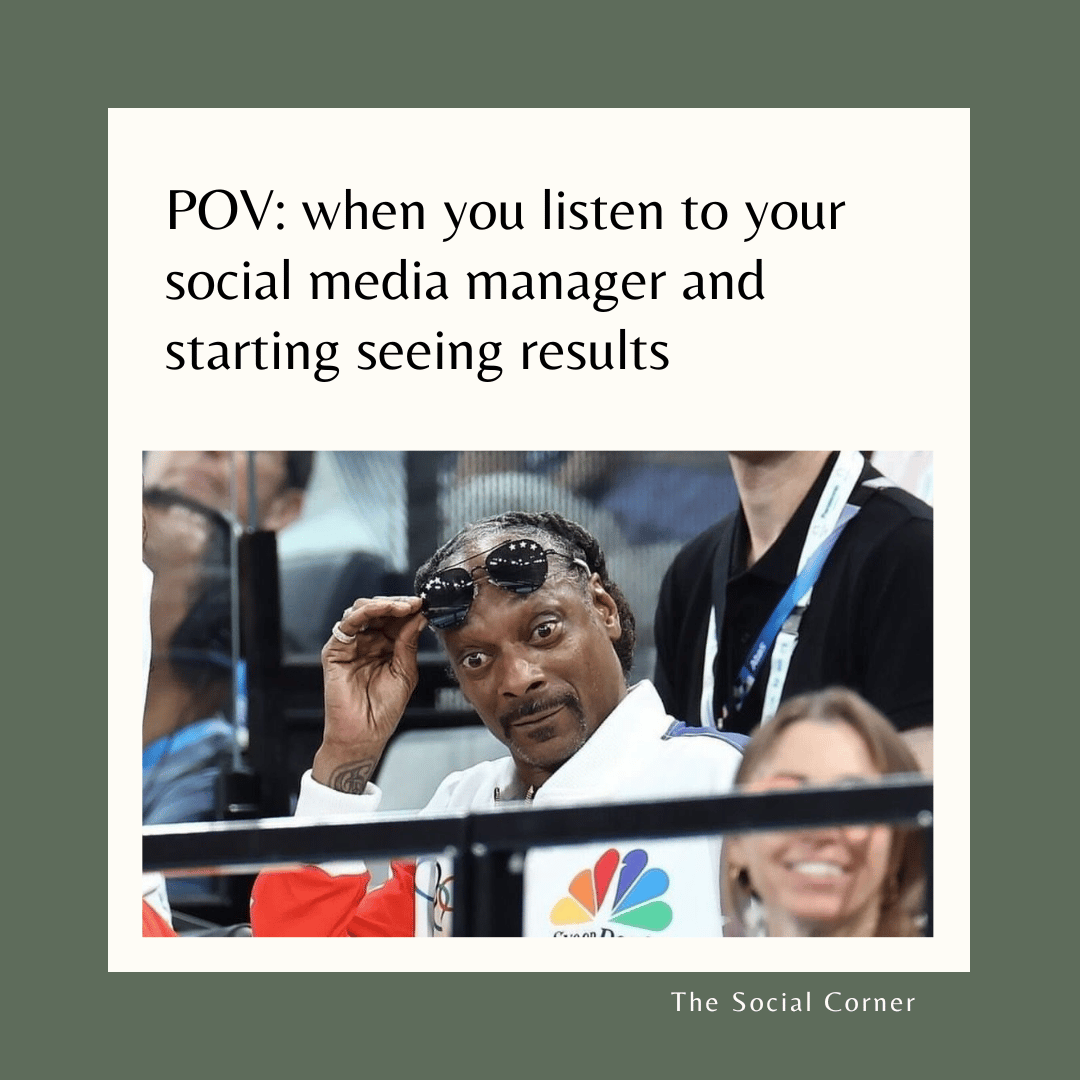- The Social Corner
- Posts
- Content Calendar
Content Calendar
What's the right scheduling cadence for you?

Hey there!
Long time no chat. Sorry about that!
I missed sending out July’s newsletter. Things got hectic at Just Be Social.
We onboarded some new clients, cleaned up some processes, and shifted gears for Q4.
Anyway, I’m back with a new edition of The Social Corner, and this month, I wanted to chat about one specific area of social media marketing — your content calendar.
Not just the calendar itself but the cadence of it all.
So, let’s get started, shall we…
🫶
Was this email sent to you?
SOCIAL MEDIA DEEP DIVE
The Contested Content Calendar 🗓️
Like most things in social media, there’s more than one way to do things — including your content calendar.
Recently, I’ve discovered that some social media marketers prefer to plan content in two-week increments while others follow a monthly schedule.
There’s certainly no right or wrong way to go about it, but planning your content out in advance certainly has its advantages:
Adds Consistency & Cohesion: Consistency helps build a recognizable brand presence and keeps your audience engaged.
It Saves Time: Batching content is a much better use of your time rather than trying to come up with posts on the fly.
It’s Strategic: Maximize the impact of your campaigns by ensuring all content supports your goals and is published at the optimal times.
So…

The Goldbergs — ABC Network (bc we give creds around here)
Glad you asked!
First of all, your content calendar plays an important role in your social media marketing.
It’s where you brainstorm, align goals, and make sure content is on brand. Depending on your situation and set-up, having your content calendar filled in at least 30-60 days ahead of time is ideal.
But we know things shift and change, so make sure you leave room for flexibility.
Outside of new service announcements, product launches, and events, things on your calendar can shift and move as long as they align with your overall business goals.
At Just Be Social, we schedule our clients' social media activities on a monthly basis. However, I can see the pros (and cons) of taking either route.
Allow me to explain…
Pros of the Two-Week Calendar
You have more flexibility. A two-week calendar allows for more frequent pivots. If you want to incorporate new trends or address sudden changes in your business, you can do so without disrupting previously planned content.
It helps you focus on immediate goals. Planning in shorter bursts can help you stay more focused on immediate goals, ensuring that your content remains relevant and timely.
It can feel less daunting. A two-week calendar is easier to manage and less daunting, making it an excellent option if you're just getting started or if you have a smaller team.
Cons of the Two-Week Calendar
It can be time-consuming. Constantly planning every two weeks can be very time-consuming, especially if you have a busy schedule or other pressing tasks (which you likely do). If you outsource your social media marketing, this cadence can also get expensive due to the time-consuming part.
You limit your long-term strategy. It’s harder to build out long-term campaigns or themes when you’re only planning two weeks at a time. You might miss out on opportunities to create cohesive, extended content arcs.
You risk content gaps. With shorter planning periods, there's a higher risk of scrambling to get the next two weeks done or missing posting deadlines altogether, which you don’t want when you’re trying to grow your brand on social media.
Pros of the Monthly Calendar
There’s comprehensive planning: A monthly calendar lets you see the bigger picture, making it easier to align your content with overall business goals, campaigns, or seasonal trends. With a monthly calendar, you can still be flexible enough to hop on current trends without feeling like you’re coming up with new content all the time.
It tends to be more time-efficient. Planning an entire month’s worth of content at once or over the span of a couple of days saves you time in the long run, freeing you up to focus on other aspects of your business.
You remain consistent with your strategy. With a monthly calendar, you can ensure that your content flows smoothly and that messaging is consistent throughout the month, enhancing your brand’s narrative.
Cons of the Monthly Calendar
There tends to be less flexibility: A monthly calendar may make it harder to adapt to sudden changes or capitalize on trending topics, as your content is already planned out in advance. But, as I mentioned above, it’s still possible because relatable or trendy content should be built into your social media strategy.
It’s easy to get overwhelmed. Planning for an entire month can feel overwhelming, especially if you’re not sure what your business or audience will need weeks from now. This is when I say, “Follow the analytics.” Your social media analytics will tell you what type of content, format, and caption worked best the month prior. Rinse and repeat!
There’s the chance of content fatigue. There’s a risk of content feeling stale if it was planned too far in advance, and you might miss opportunities to inject fresh ideas into your strategy. That’s why I always host a monthly marketing meeting with clients to review the prior month’s success and shift gears for upcoming months if need be. Again, it’s all about being flexible here.
Both the two-week and monthly calendars have their advantages and challenges.
The right choice depends on your business needs, team size, and how flexible you need to be with your content.
Whether you’re looking for a quick win with a two-week plan or aiming for the long game with a monthly strategy, planning is key to keeping your content on track and your audience engaged.
Even Future Social’s Jack Appleby has something to say about scheduling content in advance…
WHAT’S TRENDING
Faceless Marketing
Faceless accounts are trending, especially on Instagram. Plenty of gurus are promoting faceless accounts using videos or memes and hiding behind this notion that “faceless marketing” works.
You go to their pages, and there’s no human face anywhere in sight. This method of social media marketing just isn’t sustainable.
Why?
It’s disingenuous. And that’s not just an opinion — it’s psychology.
Humans are wired to pay attention to faces. We’re technically a herding species, constantly scanning our environment for friend and foe.
So, when we see faces on social media, we automatically (and subconsciously) note that person as trustworthy.
Without a face on the account, most scrollers will not trust you or your brand.
The same part of your brain that lights up when you see a face also lights up when you see face-ish cues like emojis.
Knowing this, it’s not a big leap to assume faceless marketing won’t be sticking around. I’d be shocked if it makes it past Christmas. 🎄
ICYMI
Social Media Updates
🤳🏻 Instagram increased the carousel limit to 20 slides
👀 Instagram says Views are now the most important KPI metric for all types of content.
📔 Brands can now sponsor user-generated newsletters on LinkedIn.
🎥 Facebook recently launched “Clip Hub” in Stories, allowing you to manage clips from your phone or save drafts for later.
📊 Polls generate the most impressions on LinkedIn.
✔️ LinkedIn is in the middle of rolling out Verification Badges for company pages.
📍 Instagram is testing a “Friend Map” so you can track your friends’ locations.
ON THE BLOG
FOR A CHUCKLE





